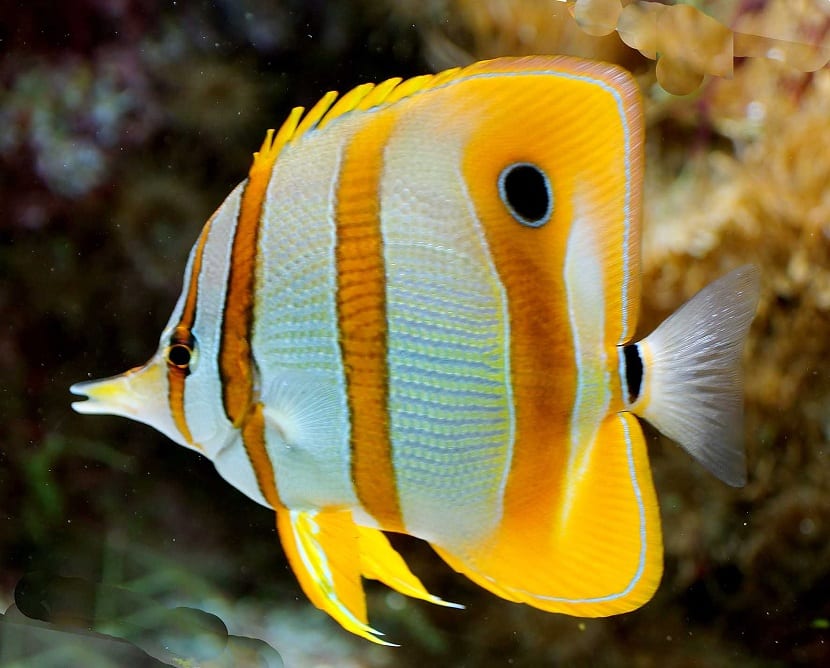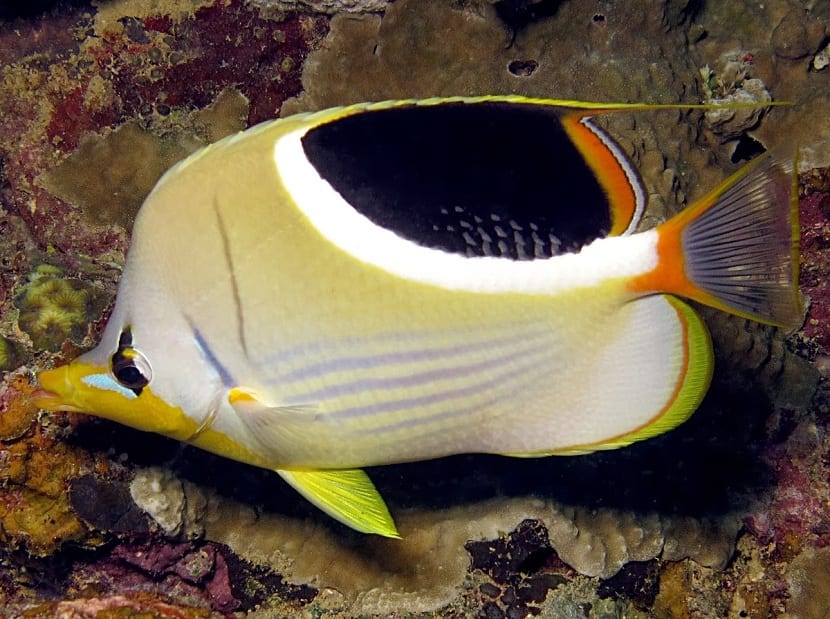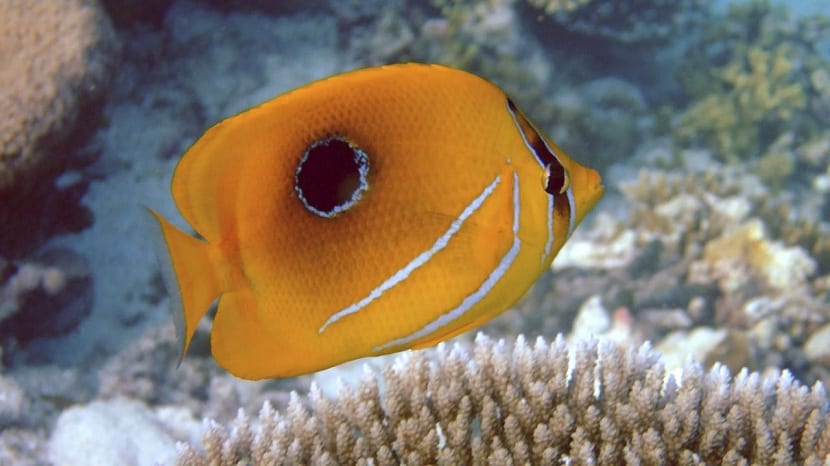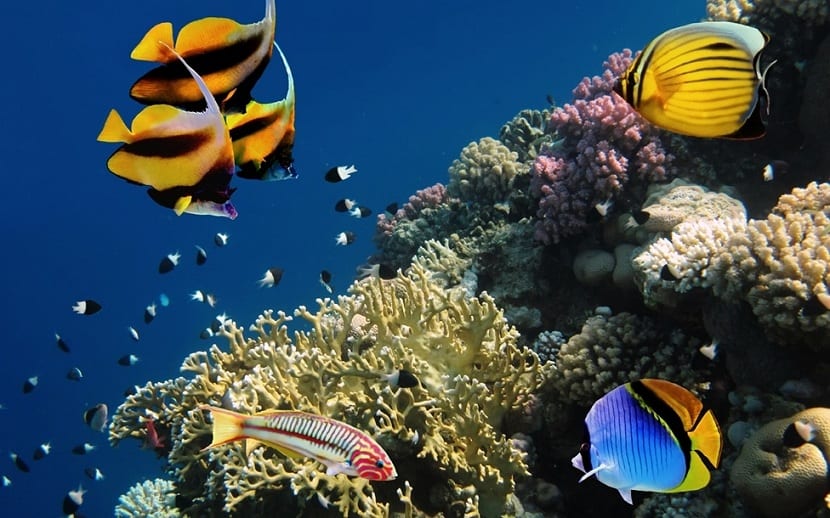
The butterfly fish is among those smaller marine fish. It can be found in tropical and subtropical waters, but today, this is not the case. The butterfly fish, scientific name Chaetodontidae, is in serious danger of extinction.
In this post we are going to talk about everything related to this wonderful fish that we can hardly enjoy because its populations are very low. They can only see documentaries and scientific magazines. Do you want to know the reason why they are in danger of extinction?
Key features

Mainly, these fish are very small in size. We can find them on coral reefs swimming in tropical and subtropical waters. At first glance they can be perfectly distinguished. The body is bright yellow and very colorful. It has some brands that give it a special feature. For this reason, it receives the name of butterfly fish.
Today, There are more than 100 species that are known de peces butterflies. They are distributed by the Atlantic, Indian and Pacific oceans. It only lives in salty waters. Being so small, its measurement is only four inches in length. It is rare that it reaches more than 10 centimeters in length.
It is known that some species of butterflyfish can reach greater lengths. If they live in aquariums and are given the care they need, they can live up to 10 years. However, in its natural habitat, they only live 7 years.
Most aquarists have ever wanted to care for a butterflyfish. Its incalculable beauty can be enjoyed if it is cared for properly. Although therein lies the problem. These fish are very difficult to care for. It requires very specific water conditions and constant monitoring. Therefore, it is more advisable that these fish have the specific conditions that nature offers them in their habitat.
Appearance and way of life

Sometimes it is confused with the Angel fish, since they have similar colors, but it is much smaller. The dark spots on its body is the most distinctive indicator that we are dealing with a butterflyfish. It also differs from angelfish in that its mouth is more pointed and it has dark bands around its eyes.
Generally, they are diurnal fish, so they feed during the day and rest on the coral at night. Their basic diet is summarized in plankton from the water, coral and anemones and some crustaceans.
The larger species are more solitary. They have a monogamous characteristic. That is, they only have one mating partner for life or until one of them dies.
They are the prey of numerous predators that try to hunt them. One of them is the wolf fish. They are also meat for snappers, eels, and sharks. Thanks to its tiny size they are capable of sneaking out of these predators and hiding. They do it in the crevices of the coral in order to escape and avoid being eaten.
Laterally they are very thin and their body shape is oval. Its snout is quite protruding and allows it to move among the rocks of the coral reef. Inside the rocks they are able to find their food. Its dorsal fin is continuous and that of the tail is rounded. It never has forked fins.
Although most have bright colors, there are also black drawings. But usually they always stand out black, white, red, blue, orange, and yellow.
Range and habitat

Before they were seriously endangered, these fish were found in all the world's oceans. Its abundance peaked in tropical, subtropical and temperate waters.
As for their habitat, they like to live near rocky and coral reefs. The depths to which it swims they are usually below 20 meters. Some species of butterflyfish do prefer to live at depths of up to 180 meters.
During the day they are found feeding near the reefs. It is there where they find their food and their hiding place from predators. At night they are swimming through the reef crevices to sleep and avoid being hunted.
Although most of these fish are solitary, some can be found in pairs. Only some of them can be found forming large groups to feed on zooplankton. Corellivorous butterflies tend to form mated pairs and claim a coral head as their home, becoming very territorial.
Butterfly fish in aquariums

As mentioned before, butterfly fish are able to survive longer in fish tanks than in their natural habitat. The aquarium has to simulate its natural habitat, although if we put a reef It will pinch it until it breaks.
Most of them can be fed by giving it algae, sponges and corals. Some can feed on small animals and plankton, as they are omnivores. They should be offered a wide range of live foods such as flakes, live brine, frozen foods of all kinds, and spirulina. There are sponge-based frozen foods that can help with your diet. These fish are very sensitive to food. If it is not fed properly, it could easily die.
Younger fish are easier to acclimate to tank conditions. They have to be fed several times a day so that they can develop well. The aquarium they need should be large enough to give them space. They also need many spaces and corners where it can be hidden. This is done to simulate their natural habitat. They are quite shy in behavior, so it is ideal to put it with calm and non-aggressive companions.
These fish are solitary or go in pairs. However, when they go in a group they are a danger. It is better not to put many specimens of the same species in the aquarium.
Regarding reproduction, we have not talked about it because they have not been able to be successfully reproduced in captivity. It is expected that they can learn to breed them in captivity and that they adapt perfectly to their environment.
With this information you can get to know one of the most curious fish in the world in depth. Have you seen any butterfly fish before?